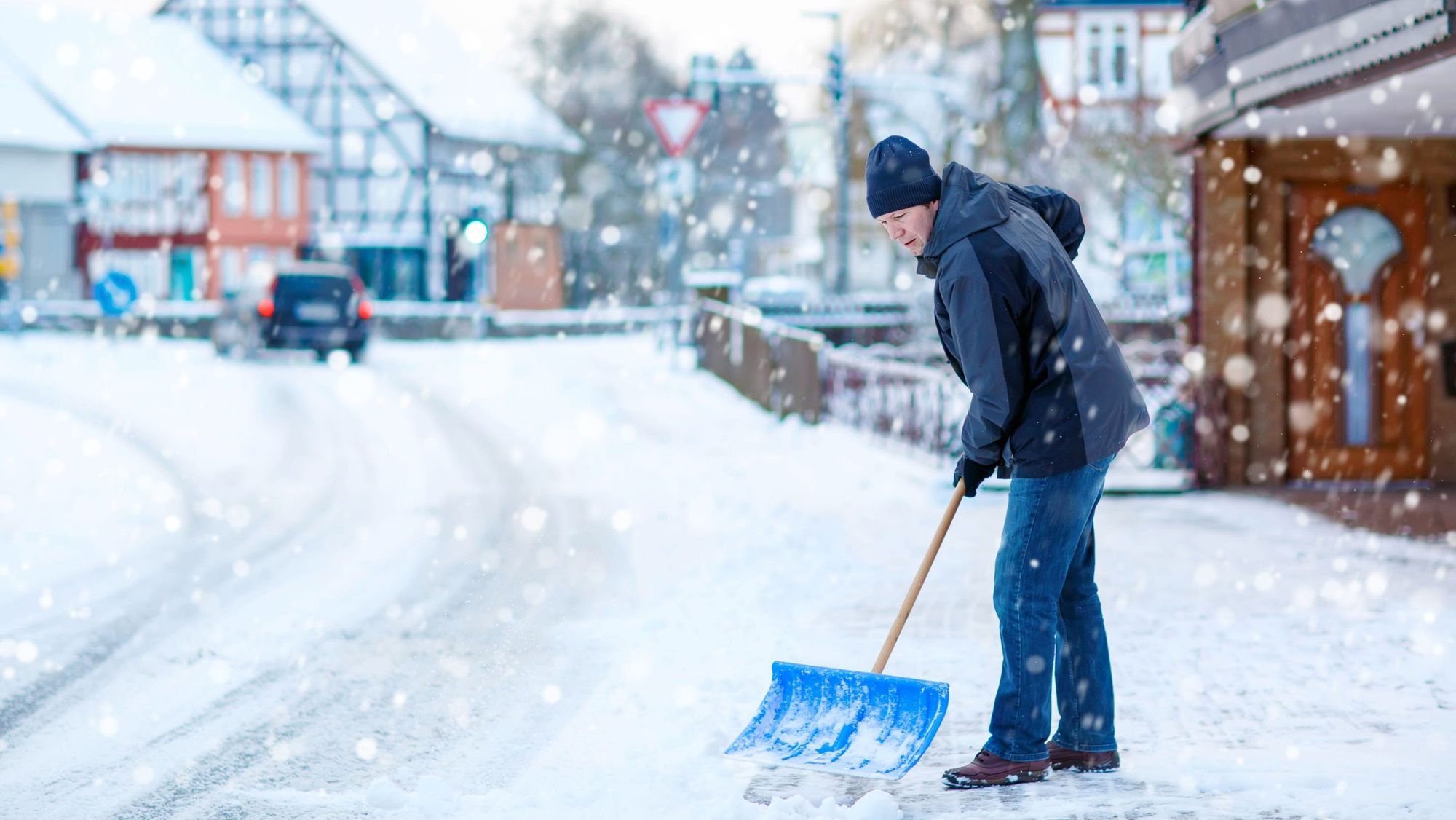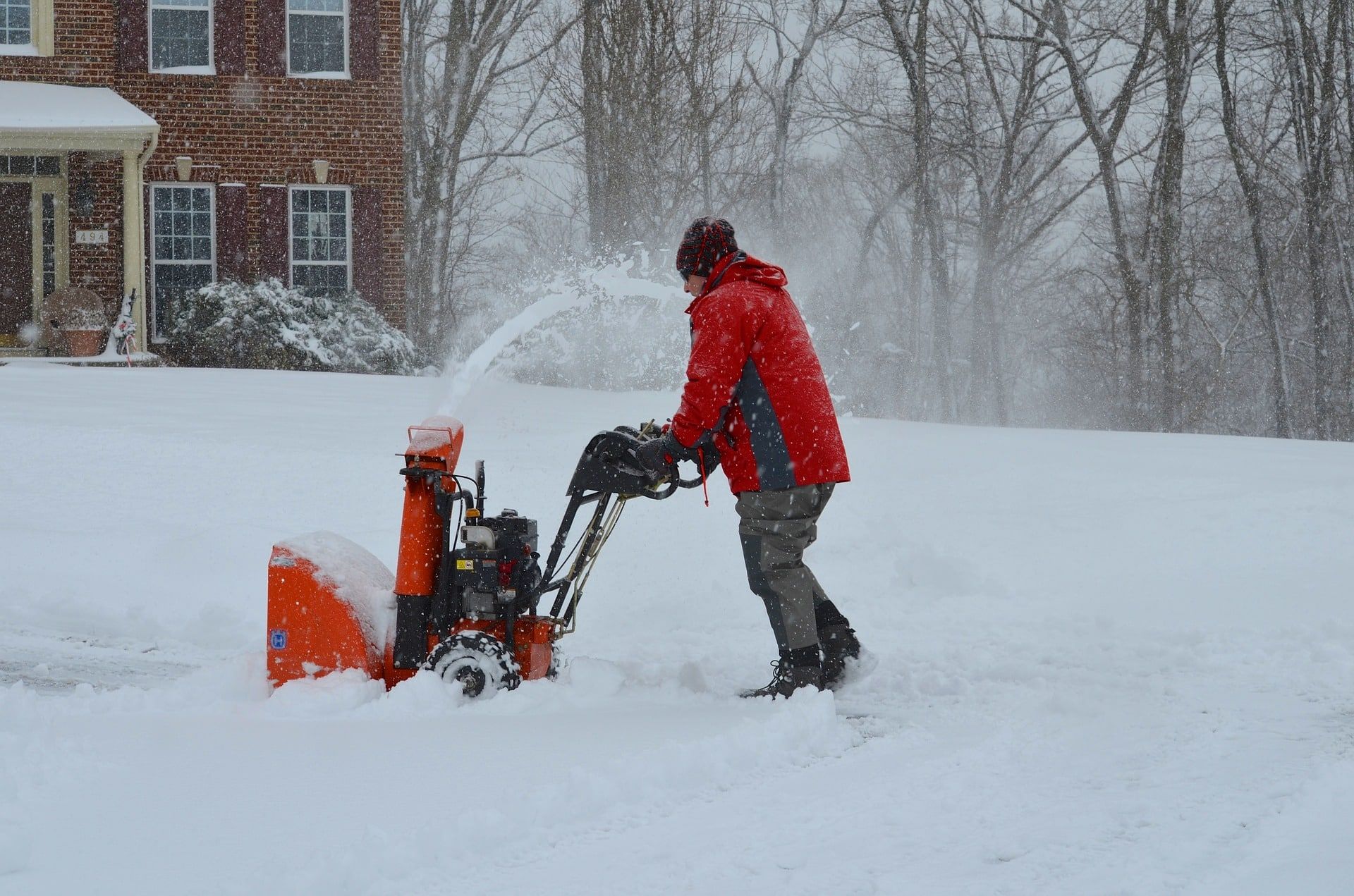Complete Guide to Snow and Snow Removal
From the quick essentials to an in-depth look at snow removal, ice removal, and the tools of the trade
With the joy of home-ownership, comes a little maintenance and work along the way. And for many homeowners, one of the most unwelcome, stressful, and even risky, is snow removal. Whether a full driveway, a sidewalk, or even just the steps up to a porch, snowfall creates a potential hazard on walking surfaces around the home. Removing that snow is not optional. From clearing the driveway so you can leave for work, clearing a path for the mail carrier, or preventing the fines that can accrue in towns and HOAs, snow removal is essential.
Table of Contents
But how best to remove the snow? There are so many options available on the market: Shovels of all shapes and sizes, snow blowers of every horsepower and width, half a dozen agents to melt snow, as well as attachments for mowers, trucks, and ATVs. With those options are the risks homeowners have to consider for each one. Will my melting agent harm my yard? Will I use the snow blower enough to justify the purchase? Could I face serious health problems if I choose to shovel the snow myself? We can help.

Snow Removal Essentials
Snow removal is the clearing of snow from drive and walkways to make travel easier and safer. Below is a list of quick tips to help put you on the right track when it comes to snow removal – and help you avoid the risks that go along with it!- Talk to Your Doctor – Before you put on that scarf and coat, make sure your doctor has agreed you are healthy enough to remove snow.
- Understand the Risks – If you are removing the snow yourself, make sure you understand the risks of back strain and cardiovascular health problems, and monitor yourself closely while doing the job.
- Snow Removal Equipment: Choose the Right Tool – Whether it is a small path, a porch, or a half-acre driveway, having the right shovel, snow blower, or plow for the job is essential.
- Know Your Snow – The difference between a light dusting and heavy lake-effect snow can make a big difference on how best to deal with snow.
- Check the Temperature – Many snow-melt products are ineffective below a certain temperature. Make sure yours will work when you need it!
- Understand the Local Rules – Does your town or HOA issue fines if you have not removed snow by a certain time of day? These can quickly add up into a costly bill.
- Know The Extras and Which to Skip – Driveway markers or add-ons for a snow blower can make snow removal easier for a reasonable price, while extravagant extras like heated driveways or heating mats can offer questionable value.
Snow Removal In-Depth Guide
Taking an in-depth look at snow removal, you will want to consider the many products available to you that help you complete the task and the serious health concerns that go along with it. If you are unsure about some of the steps, you can consult a local snow removal company for advice.Snow Removal – How Should I Do It?
Removing snow is a chore, no matter how you look at it. But understanding the job at hand, and using the right tool, can make things easier. Clearing a small path or a whole driveway? Is the snow light and easily swept away, or wet, heavy and difficult to lift? Your budget and your situation will often determine the right path forward as well.Types of Snow
Anyone who has ever tried to make a snowman only to find the snow dry and too thin to stick together can attest that not all snow is the same. In the same way, how you remove snow from your driveway, path, or sidewalk can depend heavily on what kind of snow has fallen. The exact science behind the kind of snowfall you get depends on the region where you live, the temperature at the time of snowfall, and even the kinds of crystals that make up the snow. This can vary from location to location, so take a little time to research the types of snowfall you are likely to receive. That understanding will help you choose the best method and most useful tools to make your snow removal as easy as possible.Snow Shovels – What’s the Difference?
There are many types of shovels available and you may be wondering just what the difference is between them. Below you will find the most common kinds of shovels on the market, their advantages, and drawbacks.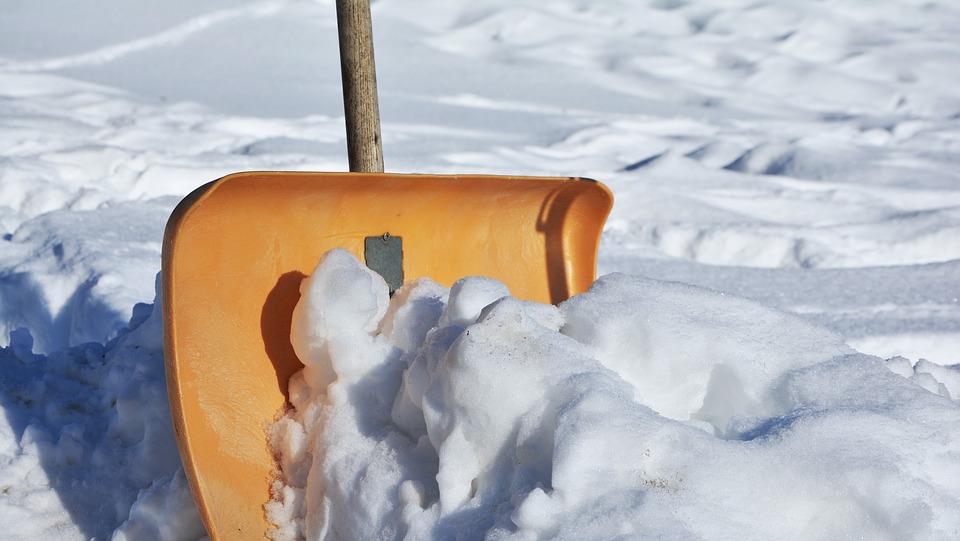
Standard
The standard snow shovel is composed of a loop or D-shaped grip, a straight aluminum handle, typically ribbed inside to provide strength to prevent bending or flexing, and a wide scoop for maximum coverage. The long handle lends itself easily to pushing through piles of snow, dry or wet. They also typically have a steel or hardened plastic strip for scraping away compact snow, or getting under loosened ice, without damaging the surface. While this no-frills model is the most common and has the best general application, its wide scoop can be ill-suited for tight spaces, and it lacks any energy-saving or injury-prevention features.
Ergonomic
An ergonomic snow shovel serves to protect you from injuring your back while shoveling. It has a bent or curved handle, providing greater leverage to do more of the lifting work for you, while allowing you to spend less energy on the task. They are typically made of lightweight aluminum and have a smaller scoop than other shovel types to ensure that each scoop of snow is lighter. One of the best features is that the shovel can eliminate the need to twist or bend, which lead to many back injuries during shoveling. Remember to keep your back as straight as possible while using this shovel type.
Detachable Handle
Shovels designed to specifically have their handles detached have two primary purposes in mind – ease of storage and reconfiguration during use. Besides the obvious advantage of taking up less space in your garage and the potential for portability, snow shovels can be designed with special handles that can provide either greater leverage for heavy lifting and removal or greater ease of pushing for those snowfalls that require less lifting and removing.
Telescoping Shovel
Designed with your car in mind, many companies produce telescoping snow shovels meant specifically to get you out of a tight spot. As the name implies, the shovel’s handle can collapse in itself or unscrew/reassemble quickly and easily to be used in emergency situations when your vehicle faces a snow obstacle. Whether stranded on a mountain road or spinning your tires in the parking lot as you are trying to get home from work, keeping a small telescoping snow shovel handy is something many in snowy regions swear by.
Corn Scoop
More at home on a farm than in your suburban garage, the corn scoop style of shovel is an effective snow remover in the right situation. With a narrower scoop than standard or ergonomic shovels, it can fit into tighter spaces and is especially effective at lifting piles of wet, heavy snow. The short wooden or fiberglass handle makes it a poor choice for plowing snow. And the narrow scoop means you will have to take many more passes in a large area. This tool is best used situationally.
Why Is Snow Sticking to My Shovel?
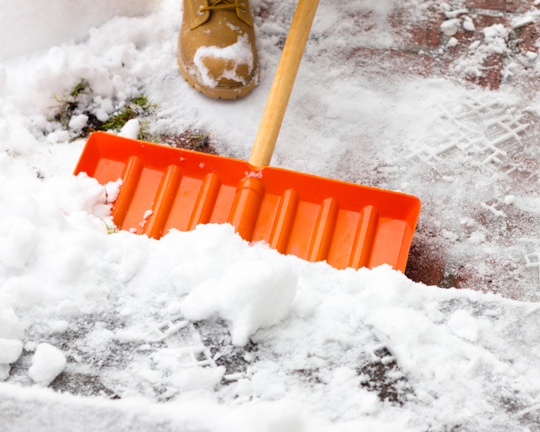
- Wax On – Just like with skis, snowboards, and surfboards, a good coat of wax can easily solve the problem of snow sticking to your shovel. Depending upon the grade and quality of the wax you use and the condition of your shovel, a single application of wax may last for several snowfalls. Waxing products for skis and snowboards, a thin coat of paraffin wax, and even car wax, are effective.
- Oil-Based Cooking Spreads and Sprays – Short on wax? Head to the kitchen and grab the cooking spray. Oil-based cooking sprays, vegetable oils, and cooking spreads can coat your shovel blade to stop snow from clinging as you remove it. Some studies suggest that a coating of oil like this also can prevent rust on a metal blade. Just be careful to clean it before you put it away.
- Petroleum Jelly – The same as cooking sprays and coatings, petroleum jelly also can get the job done. There is evidence it can last slightly longer than cooking spray type applications as well.
- Other Substances – Recommendations to stop snow from sticking to your shovel range from motorcycle chain lube to WD40 and gun cleaner. Use your best judgment, weigh the risks to yourself, your home, and the environment before using any substance to prevent snow stick. At the end of the day it is probably not worth taking a risk to prevent half an inch of snow from clinging to a shovel.
Keep It Cold
Outside of anti-stick coatings, the biggest factor in snow sticking to the shovel can be the temperature. Storing your shovel outside in a snow-protected area can greatly reduce the chances snow will stick to your shovel. A caution, however, if the temperature is above freezing outside, your shovel may still be too warm to stop snow from sticking. There are ways you can lower the temperature of the shovel, but all of them involve the use of chemicals that may have a negative impact on the environment, your driveway, your yard, or even your own health. It may be best to use an anti-stick hack as listed above.Snow Blowers
If your driveway is large or you are tired of removing snow by hand, one of the most popular and easiest solutions available is a snow blower. But which one should you buy? There are dozens of models, attachments, styles, sizes, and brands that range in price. The guide below will help equip you with the knowledge you need to pick the right snow blower for your home.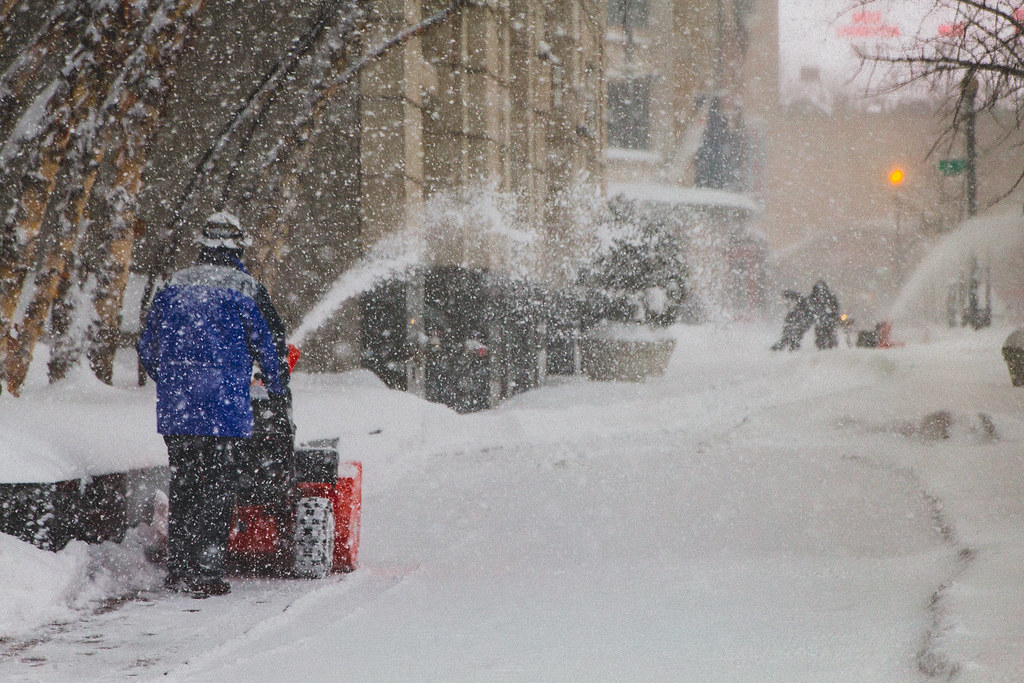
There Are So Many Snow Blowers to Choose From…
It is fair to say there are dozens of brands of snow blowers to decide between. Some models on the lower end might only cost about $150 dollars, while some of the heavy duty professional grade models can run into the thousands. This is driven by a few factors, but the most basic way to determine which is best is to consider your situation. If your area receives only one or two heavy snowfalls a year and your driveway is small, it could be OK to go with a less expensive model. If you are used to waking up 40 times per winter to clear a long driveway of deep snow, it might be best to spring for an upgrade. But how to know what is “just right” for your situation?So What Is the Difference?
Ultimately, the difference between each snow blower model can be boiled down into a few simple categories. Considering these will help you understand which type is best for your situation. And once you understand that, you can start to investigate the brands, models, and costs that fit you best.- Gas vs. Electric – Most electric-powered snow blowers are single stage or what you might think of as the lightest duty models. These generally will not offer you overwhelming power, but get the job done for many homeowners who are only clearing a path and a short drive. Gas-powered models are the two and three stage versions of the snow blower, offering you power, self-propulsion, and raw clearing capability that surpasses any single stage electric model. Environmentally minded folks may avoid the gas-powered models, but understand that you will lose power by doing so. Many electric-powered snow blowers also require extension cords rated at the proper amperage, which can make some users wary since it will be sitting in snow (i.e. water) during use.
Number of Stages
- Single Stage – These are named for the fact that there is only one “feature” of the snow blower doing the work of picking up and moving the snow. The work is done by a corkscrew-shaped piece in the body of the snow blower (the auger) that spins along the ground picking up snow and pushing it out of the discharge chute, usually made of plastic. This discharge chute can be aimed in different directions. This type of snow blower is best for light snow and is typically a “no frills” model, often lacking self-propulsion capabilities. They can be powered by gas or electric. Since the auger contacts the ground it is not usually a good idea to use these on uneven or loose gravel type surfaces.
- Two Stage – As with the above, these are named for the two “features” that split the work of removing the snow. They possess the auger of the single stage, but instead of moving it to a chute on one side, they move the snow to the center where an impeller or fan, the second stage, sucks up the snow and throws it out of the chute. Often the auger blades are serrated, which helps cut up thicker snow. They do not contact the ground, meaning they are better for gravel and uneven surfaces. Generally being fueled by gas, they almost always feature powered propulsion, meaning they could be used on slopes with ease.
- Three Stage – The ultra-heavy-duty version of the two stage, three stage snow blowers typically include another auger and a powerful system for acceleration. They can clear massive amounts of snow in no time at all because they do not need to slow down for heavy, wet, or thick snow. But these models are not something an average homeowner will need. The extra power they offer is usually best suited for large spaces that need clearing in a short time, and will offer little value on your typical driveway. In addition, the extra complexity of their engines usually require professional maintenance, unlike a single or two stage model, which lend themselves to DIY service. On the other hand, owners of rental properties may find this type of snow blower useful in clearing multiple driveways or large parking lots quickly.
- Width – You can think of the width of the snow blower as its clearing capability. Typically snow blowers range between 20 inches to 48 inches in the width of their deck. The decision about width should be based not only on the size of the areas you need to clear but also, importantly, the width of the area you are going to store it. While it can be tempting to buy the widest model you can and clear your driveway in a couple of passes, is it worth giving up your garage parking space or having to build a new shed?
- Features and Attachments – There are as many additional options, attachments, and snow removal tools available for snow blowers as there are snow blower models. The list below will give you an idea of some of the many extra features you can consider.
- Lamps
- Power Drive – Multi-Speed/Gear
- Deflector Shields
- Drift Cutter
- Cabs
- Ice Scraper
- Heated Grips
- Tire Chains
- Weight Bars
Read the Reviews
So you have decided the best type of snow blower for your situation, but you have discovered there are at least 10 brands that produce the exact thing you need. What now? You are not the first person who has faced this problem, which gives you a real advantage. Check the review sections of major retailers as you are doing your research. Once you know which model you need, let the experience of others guide your choice.Snow Removal Vehicles
If the job is big – like a company parking lot, a rental property, or an acre-long driveway – then it may be time to employ the use of a vehicle for your snow removal. But what should you use? There are plenty of options – from attachments for your SUV or riding lawn mower to full-on heavy machinery. What you end up using will largely depend on the situation, and the below guide can help you best determine your level of need.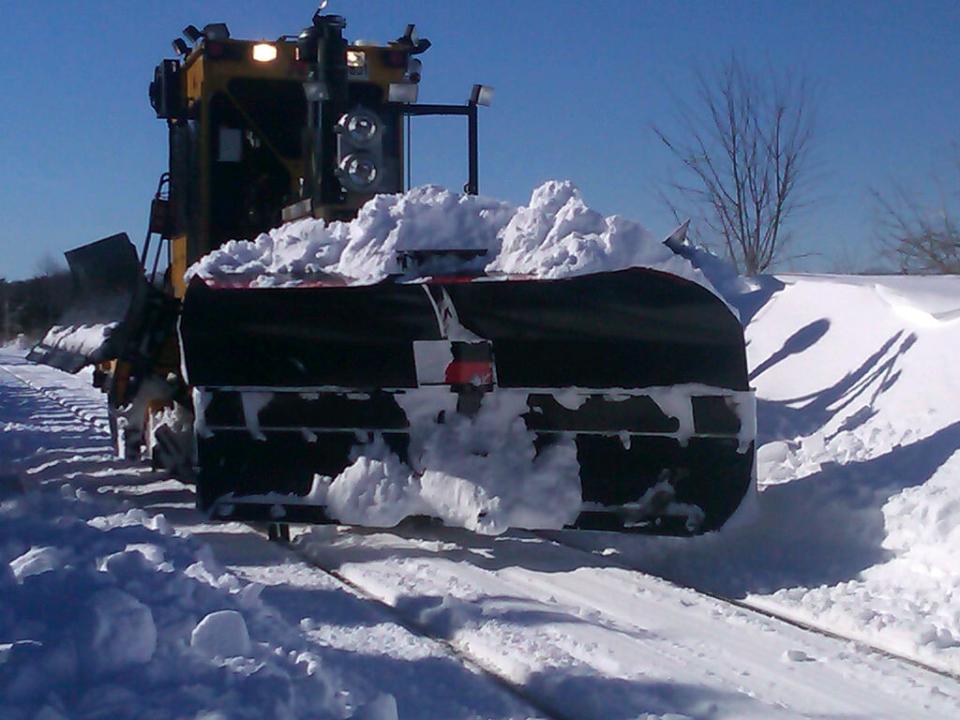
Passenger Vehicles
Trucks or SUVs with a snow plow on the front are a classic sight, and the options available can be reasonable if the job is big or you need to plow multiple locations. Most snow removal services and contractors utilize this option, allowing them to clear snow at multiple locations quickly, safely, and easily. However for your average residential homeowner, this option can be seen as a bit of overkill. Plus, unlike a contractor who is using the plow attachment multiple times with every snowfall, those unfamiliar with plow operation run the risk of damaging property, other vehicles, or even their own vehicle without the proper preparation. Consider carefully before you find you have pushed a mailbox into a ditch.
ATVs and Riding Lawn Mowers
There are many plow attachments available for ATVs and riding lawn mowers. And while it can be appealing to put away the shovel and hop onto the 4-wheeler, there may be a reason to pause. Some studies suggest that using your recreational vehicles or your riding mower for the removal of snow may shorten its life.
Even the best attachments may ultimately result in damage to the engine or mechanical components of the vehicle. Plus, there are added concerns such as installing the equipment every year when winter starts, then uninstalling it in spring. If you are installing to a riding lawn mower, it may be necessary to fully remove the lawn mower deck as well – a task which, for many homeowners, will require a mechanic.
Perhaps most compelling, many of these attachments, with all their added labor, are comparable in cost, and at times more costly than simply purchasing a snow blower or hiring a snow removal service. However, if you lack the space to store a snow blower, this could be an option to examine. Just bear in mind its drawbacks.
Heavy Machinery
If you have a very large space or a full business, there are many heavy machinery options on the market that can remove large amounts of snow with each. Scoops and snow pusher attachments for your Bobcats, trucks, and loaders are widely available commercially and are worth investigation if you have a big space with a dedicated need. For the average homeowner, these options are not usually practical.
Other Snow Removal Tools and Methods of Snow Removal
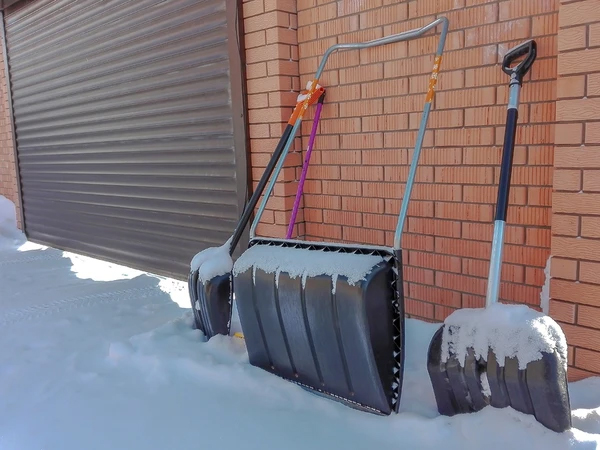
Sometimes the right tool for the job is not the immediately obvious choice. Below are some items that can help you take care of unique or tricky situations or offer you an unusual way of taking care of the snow removal job.
Secondary Grips
Some curved or straight handle shovels allow for a second grip to be installed around halfway down the length of the shovel, providing excellent leverage and helping to prevent back injuries while scooping large piles of snow. Some brands of snow shovels provide these attachments standard or for purchase at a low cost. It is important to be moderate when using this tool, however. It can be very tempting to use the extra leverage it provides to lift heavier and heavier piles of snow – but that is an easy way to injure yourself!
Hand Snow Pusher
With a long, wide-loop handle reminiscent of a push lawnmower, a wide metal or plastic scoop attached to the front, and some models possessing two tough plastic wheels, the snow pusher is a tool best suited to clearing a wide, flat space covered with a light amount of snow. This tool requires no bending or scooping, and is very easy to use if clearing an evenly level path, deck, or driveway. However, it does little more than push snow to one side or another, meaning if you need to move snow to a different area this is not the tool for the job. With its added limitation of only being able to clear light (less than a few inches) of snow, it also is not recommended for those in areas that receive heavy snowfall.
Snow Sleigh
While its name brings to mind childhood winters and hot chocolate by a fire, snow sleighs are in fact a heavy-duty version of the hand snow pusher. Its handle design is very similar to the snow pusher, much like a lawnmower handle. The difference is that the snow sleigh has a large, flat scoop in place of the wheels and small scoop of the pusher. It is made to slide across flat surfaces, collecting snow and pushing it to one side. It also provides a serious snow capacity upgrade from the pusher, with the ability to take on heavy, wet snow piled several inches high, if necessary. One drawback is that it may take more strength to operate than the pusher, and by that token, may lead to a greater risk of injury.
Brooms
If you have received a very light amount of snowfall or you are in a pinch without a snow shovel, an old-fashioned broom can get the job done. Obviously, you are not going to be able to move a pile of wet heavy snow using this tool, but if you are clearing a dusting of snow on a porch, sometimes keeping it simple is best. Remember to leave your broom somewhere warm to dry once you are done, like a laundry or mud room where some dripping will not be an issue. Bear in mind that using an indoor broom outside can cause it to collect pebbles and other debris that can scratch interior surfaces later!
Ice Spear/Scraper
While a bit of a misnomer, ice spears are essentially sharp scraping tools meant to break up thick ice from a surface so that it can be easy removed by a shovel. Consisting of a grip, a long straight handle, and a metal blade that is typically broad, this tool can be used to penetrate, crack up, or get underneath ice and break it apart. The pieces left behind can then be scooped away easily. Some models are spring-loaded to help ease the strain of using them. Avoid using these on wood or other surfaces prone to scrapes, scratches, and nicks.
Roof Rake
A wintery rooftop certainly looks pretty as it shimmers in the sunlight. But a heavy, wet snow can create the threat of stress, leaks, and ice damming. It can be dangerous to climb onto a snowy roof, even if you are as careful as possible. So to clear your roof and maintain your safe position at ground level, there is a snow removal tool called the roof rake. Consisting of a telescoping pole, angled at the end, and a long, flat plastic or metal “rake”, it pulls the snow down off the roof towards the ground or your gutters. Many are designed to leave about an inch of snow on your roof as well to prevent scrapes and damage to your shingles.
Leaf Blower
If you have a very light dusting or the snow is particularly light, a leaf blower is can be an option. However, most find that the snow simply settles back onto other surfaces (or onto cars, if clearing a driveway) and kicks up a localized cloud of snow. Additionally, electric powered snow blowers that have to be plugged in to operate may create a hazard (electrical wires sitting in a wet pile of snow may not be the best idea.) Overall, this would seem to be one of the least optimal snow removal options. But, it is an option.
Salt and Ice Melt – Which Should I Use?
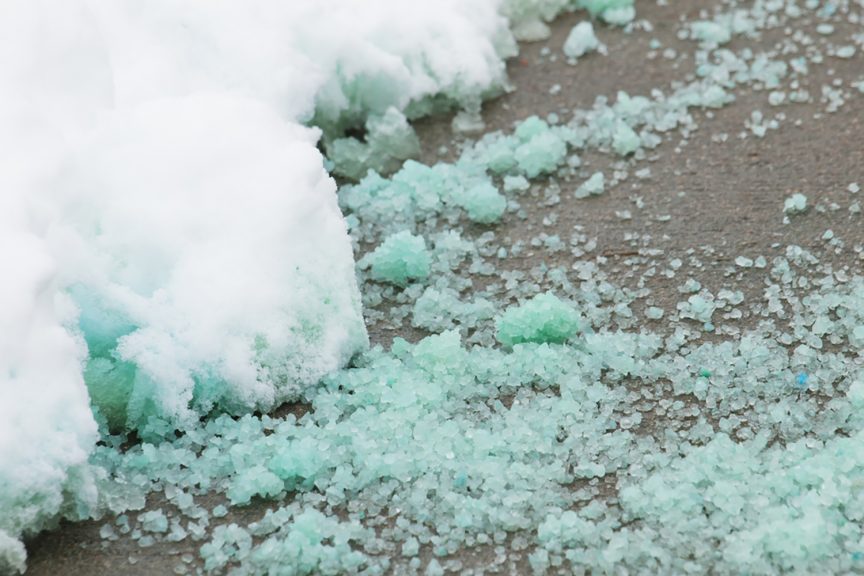
For keeping a driveway free from a light snow or the more dangerous threat of ice, many homeowners turn to salt and other ice melt products. But which is best? This often depends upon the temperature of your location, the size of the area you are keeping clear, and your own potential impact to the environment.
Rock Salt and Ice Melt – How They Work and the Risks
The way that rock salt and ice melt get rid of ice is actually a chemical process that lowers the freezing point of water itself. But this has an obvious drawback – if the temperature gets too low, the ice will simply refreeze, or never melt in the first place. This means that the average temperature in your area is one of the chief factors in determining which ice melt product you should use.
Beyond this, there are other concerns and considerations with the use of salt and ice melt products. Salt is cheaper than other options, but it causes rust to vehicles, and the potential for environmental damage to vegetation and wildlife. Ice melt agents – chemical compounds that lower the freezing point of water – are often toxic to humans, and can run the risk of contaminating ground water.
What’s It All Mean?
At the end of the day, you will have to decide which ice melt product fits your situation. This decision will be made based on the balance of cost, temperature, and impact to the environment. Below are some of the many options available to you – including some organic ones.
Different Types of Ice Melt
Below are some of the various kinds of ice melt available in stores. These are chemical compounds with varying degrees of toxicity to humans and the environment. Some also may cause damage to your drive and pathways. Careful consideration should be given prior to their use. Additionally, some of them can be quite costly. It is best to go with the least expensive option that will work for you based on the average temperature you expect to experience.
Potassium Chloride
- Effective as low as 12 degrees Fahrenheit
- Typically costs about twice as much as rock salt
Calcium Chloride
- Effective as low as -24 degrees Fahrenheit
- Typically costs about three times as much as rock salt
Potassium Acetate
- Effective as low as -70 degrees Fahrenheit
- Can be eight to 10 times costlier than rock salt
Organic and Natural Options
If you want to go green and avoid chemical ice melt or rock salt, there are options available to you. Below are some creative snow and ice removal ideas. Their effectiveness, expense, and how you acquire them may present challenges, so bear that in mind as you consider these options.
- Urea
A natural gas byproduct that is useful in removing ice at the same temperature ranges as rock salt. It can cause damage to vegetation, however.
- Beet Juice
Beet juice contains around 12% of the sodium chloride that composes salt, but along with its other properties it is enough to melt the ice in the same temperature range. It also may be better for car rust prevention than traditional salt. But some studies suggest it can be dangerous to local wildlife in large quantities.
- Salt Brine
A mixture of salt and water that coats paths, driveways, and roads and is very effective at melting ice. This can be purchased or even made yourself if you have the proper facilities at hand. There are many guides online that will instruct you how to make salt brine for snow and ice removal, but many caution that the complexity of the process can be prohibitive for those not properly equipped. Additionally, there is some evidence that suggests this method is more likely to rust a vehicle than traditional salt. Bear these factors in mind if you pursue this option.
- Hot Water
Old-fashioned hot water can melt ice just as well as anything. However, it can definitely be risky to carry hot water any distance, and the chances of the hot water melting the ice only to cool and form ice again are high. But if it is the only option available to you, it can be worth a (very careful) shot.
Other Helpful Items Related to Snow Removal
Beyond the removal of ice and snow, here are a few tools and items that could come in handy when dealing with snow removal.
Driveway Markers
Ever make bump into something when baking out of your driveway? It’s a classic error. Now imagine you cannot even see what you are doing as you reverse. Driveway markers, or plastic posts with reflective tops, are inexpensive and can be useful to mark the edges of your driveway prior to snowfall. That way when the accumulation builds up you will not find yourself stuck in the grass, creating ruts you will have to fix in the spring.
Walkway or Driveway Heating Mats and Systems
Certain companies sell mats or systems that will heat your sidewalk or entire driveway. This can be an attractive idea – who would not want to flip a switch and watch the snow melt away? However, these systems are often expensive – sometimes extravagantly expensive. Additionally, there are questions about the reliability of such systems, their durability, and the energy cost of running them. Unless you have a very serious interest in these systems, it is probably better to handle snow the old-fashioned way.
Shoe Tray
When it is all over and you are ready to take off those snowy boots the last thing you want is to ruin your floor with snow, ice, salt, and dirt. Shoe and boot trays come in all shapes, colors, and styles – and even better, they are not expensive. Make sure your mud room, foyer, kitchen, or any other entryway into your home has one handy for the winter months!
What if My Car Gets Stuck?
Eventually, the time will come. Your car will get stuck in the ice and snow. Whether trying to get into your driveway at night after a snowy day at work, or stranded on the side of the road, it can be important to have a means of getting your car moving again. Below are some suggestions to help you gain traction and get unstuck.
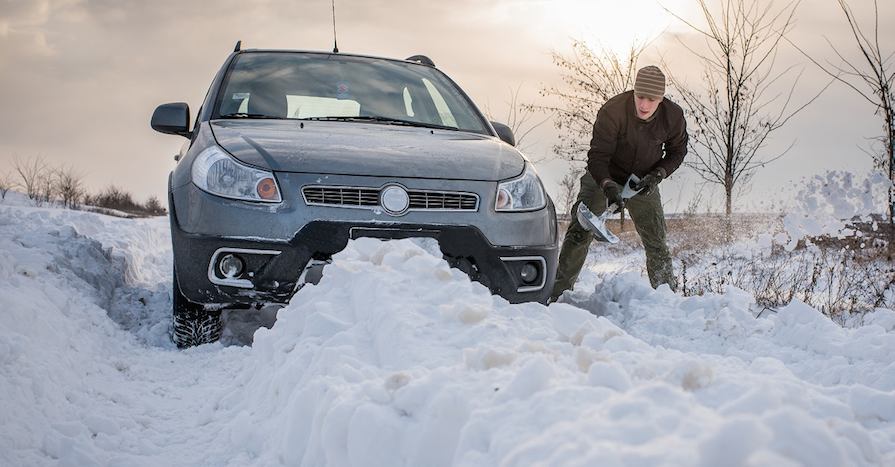
Clear Your Tires
Use your telescoping shovel, ice scraper, or even an old magazine to get as much snow away from your tires as you can. The purpose here is obvious – the snow is your problem, so getting rid of it is part of the solution. This can be a good reason to keep snow removal tools in your vehicle.
Put The Chains On – If you have snow chains for your tires, have them stored in your vehicle, and if you have not had the chance (or reason) to install them, now is the time. Snow chains are an extremely effective way to gain traction and many install easily in a very short amount of time. Make sure you have some cardboard or plastic (such as the lid of a tote) to kneel on so you keep yourself warm and dry while installing them.
Lay Down Some Traction – Once your tires are clear, add a little traction using some of the classic mainstays like rock salt, cat litter, or pieces of cardboard. If you are in a pinch, gather some nearby gravel or mulch and put those under the path you need your tires to trek. If you are on your way home from the grocery store and in a serious bind, even table salt can be helpful — whatever you can use that is reasonable and likely to give you traction. Some brave folks even use their own car floor mats for this purpose, but it might be best to save that as a last resort.
Toggle Your Settings – If your car has traction control, all-wheel drive (AWD), 4-wheel drive, or other configurations you can activate or deactivate, adjust them into each configuration and attempt to move the car.
Rock and Roll – A classic method, rocking your car back and forth (accelerating forward until stuck and then reversing until stuck – repeat) is a great method to build up momentum, which can break you free from the snow or ice keeping you stuck. But be very careful – this method can cause your car to break free quite suddenly. If you are not ready, you could hit another car, building, or end up even further in a ditch than you were before.
Slightly Deflate Your Tires – This should not be done unless you are really stuck and out of options. Deflating your tires slightly, until they visibly flatten a bit, will allow you to get more traction on the road by exposing more of the rubber of the tire to the surface you are driving on. But this can be risky, even flat dangerous, because it can wear your tires in a way that may flatten them, or even cause a blowout. There is a lot of risk to this method, and it shouldn’t be used unless it is an absolute emergency. If you are going to do it, make sure you will not have to drive on deflated tires for more than a very short distance before you can fully (and safely) refill them to proper levels. Make sure to check for any damage after you’re free, and do not drive on damaged, or even potentially damaged tires!
Be Prepared

Most of the options above require you to do a little bit of prep work in advance of stuck in the snow. Making a small preparedness kit and storing in your trunk or the back of your vehicle will make life much easier when the situation arises. Prepare now.
Avoiding HOA and City Fines
There is nothing quite as frustrating as walking up to your car and finding a parking ticket on the windshield after you forgot to pay the meter – unless it is getting a citation and fine for failing to remove snow. Make sure you do a little research, and understand all the rules and regulations that apply to you where you live.
Homeowners, even those who live in rural areas, can be subject to the rules of an HOA, a municipality, or their local government. These rules can state the depth how and when snow must be removed from driveways and sidewalks (often as low as 2 inches) and the amount of time you have to remove it (often requiring removal within just a few hours of snowfall!) But just like knowing you have to pay the meter, these penalties can be easily avoided by knowing and understanding the rules.
Serious Health Risks of Snow Removal
Although you might hear about it on the news and see examples online every winter of people dying while shoveling snow, many fail to grasp just how seriously risky shoveling snow can be. Shoveling snow is as intense on your body as doing a full workout. In fact, there is evidence that it can be as tough on your cardiovascular system as a stress test your doctor might administer. More than 11,000 people a year are hospitalized for snow shoveling-related health events – slip and fall injuries, contusions, lacerations, concussions, orthopedic injuries, and heart attacks. Before you pick up that shovel, you need to understand your risks. And most importantly, you must check with your doctor before shoveling snow to make sure you are in the proper physical condition to shovel snow.
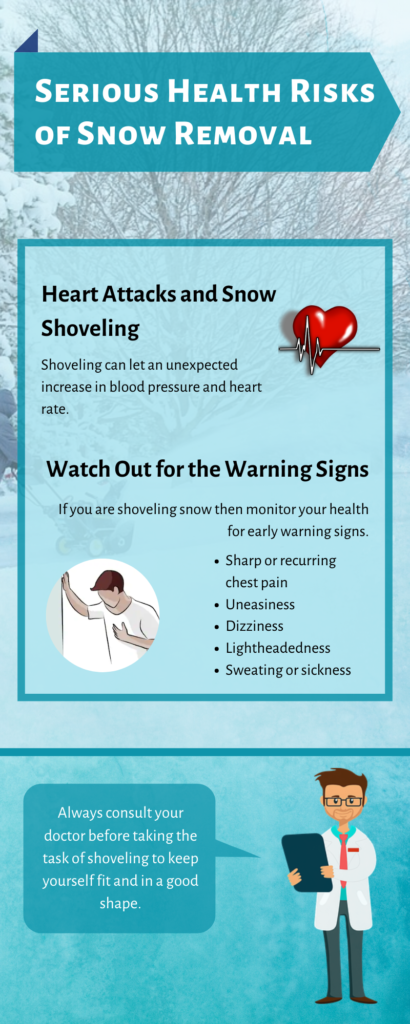
Heart Attacks and Snow Shoveling
The strain of the cold and the exertion on your body as you are shoveling snow is intense. This can create a deadly scenario for at-risk groups, like those who have hypertension, high cholesterol, smokers, or those who have had previous strokes or heart attacks. Additionally, anyone older than 55 may be at risk just by picking up the shovel and heading out into the cold to clear a driveway.
Watch Out for the Warning Signs
Your body has its own ways of telling you when something is going wrong. If you are shoveling snow, no matter how healthy you may think you are, you must always monitor for the early warning signs that you need to stop shoveling, go inside, rest, and potentially seek medical assistance.
- Steady Chest Discomfort
- Sharp Chest Pain
- Recurring Chest Pains
- Pressure or Squeezing in Chest
- Shortness of Breath and Light headedness
- Nausea
- Cold Sweat
Reduce Your Risk
If you do decide to take on the task of snow shoveling, and you have already discussed with your doctor that you should be in good enough shape to do so, then it is critical you do everything you can before, during, and after shoveling snow to reduce your risk of injury and cardiovascular event.
Keep Your Cell Phone On You
Make sure you bring your cell phone with you. In the case of a medical emergency, it is critical that you are able to dial 911 and summon help as quickly as possible. If your phone is not waterproof and you are concerned about shorting it out in the snow, try sealing it into a zippered plastic sandwich bag before putting it in your pocket.\
Bundle Up
Just like when you went out to play in the snow as a kid, it is important to layer up and stay as warm as you can while outside shoveling snow. Multiple layers on your body, a scarf, and a hat will keep the warm air trapped, and make sure your body does not have to work as hard to maintain its own heat.
Avoid Alcohol Before Shoveling
While having a drink can make any unpleasant task just a little bit more bearable, it also might end in a trip to the hospital if you choose to have one prior to shoveling snow. The warm feeling you get from the drink can cause you to misjudge how cold you are, leading to a risk of hypothermia or overexertion. Additionally, some studies show alcohol before exercise may be bad for heart health.
Shovel in the Afternoon
Statistics show that most heart attacks occur in the morning and that morning heart attacks are actually well more damaging than their afternoon and nighttime counterparts. If you can safely wait until the afternoon to shovel, you might be best served to do so.
Warm Up – Then Stay That Way!
Make sure you do some light exercise before you shovel snow – stretching, jogging in place, etc. Treat this the same way you would treat any serious exercise – because it is!
Drink Water, But Not Coffee
You should be as hydrated as you can if you are exercising. Those same rules apply when shoveling snow. You might be cold, but that does not mean you also cannot be getting dehydrated. On the other hand, having caffeine right after shoveling snow raises your blood pressure even further, and increases your risk for a heart attack or other cardiovascular event.
Do Not Smoke and Shovel
Smoking raises your heart rate and blood pressure and reduces lung function. None of these things will help you to get through the task of shoveling snow – particularly not in a safe way. Wait at least an hour after finishing the job to smoke.
Take It Easy – Shovel Less
It is important to shovel at a reasonable pace and only a reasonable weight. Some shovels, particularly those with two grips, can allow you to lift a tremendous amount of snow with every single pass. That is a good way to injure yourself quickly if you are not approaching it in a careful way. Start slow and pick up less snow than you think you can. Slowly work your way up to a comfortable level, then stay there. Snow shoveling is not the time to push past your limits if you do not want to end up at the hospital.
Watch Your Back!
Back injuries from snow shoveling are common, but not inevitable. A good shoveling form (and the right shovel) can save you from days on the couch aching. Bending at the waist can throw your back out. Instead, favor a neutral position for your back in which your spine is curved naturally, the let your legs do the lifting. The quads and glutes are much better suited for lifting than your back. Push and plow with the shovel as much as you can (but do not overload the shovel). Finishing lighter areas with a broom instead of lifting with a shovel also can help.
Do Not Be Afraid to Take a Breather
Taking a break might not sound appealing when you are trying to get the job done as quickly as you can. But studies show it is critical to know your body and stop when it is telling you to. Do not ignore the signs mentioned above. The moment you start to feel tired, it is time to take a rest. If you cannot get through much of the job without feeling tired, it might be time to revisit with your doctor whether you should be shoveling snow at all. Ultimately, your doctor may recommend you hire a snow removal service to handle the task for you.
Snow Removal Companies

If you have decided that snow removal is something better left to the professionals while you enjoy the warmth of your home, there are many options available to you. But many homeowners find the process of hiring a snow removal company confusing, and do not know what to expect or how much they should be paying for it. The good news is that it is easy to understand and may be the best choice for you. This is particularly true for people in at-risk groups.
How Does It Work?
Contracting with a local snow removal service is typically very simple. Most will quote you over the phone, and the best will provide you a quote through their website or mobile application (app). Their questions will be simple — from the basics such as the length and width of your driveway (often expressed as either feet in length or by the number of cars it holds) and anything special about it they need to keep in mind (such as a loop or teardrop.) Then they will discuss the extras – paths, walkways, patios, stairs, and landings. And they may offer anti-slip applications or to spread ice melt. For many, you can schedule them to arrive every time it snows or only when snow surpasses a certain height.
But How Much Does Snow Removal Cost?
The cost of having a snow removal company take care of your snow will vary and is easy to determine. Much will depend upon where you live. Prices can differ by region and are based on the availability of local contractors ready to take on the work. Additionally, the price will depend upon what you need to have cleared and any extras you might be interested in, as described above. If you need only your driveway to be cleared of snow, then the cost will come down to the size of the driveway. Additional cost can be incurred for the extras such as clearing a path, or your front stoop, and for laying down anti-slip agent and ice melt. Typically, the fees for these additional services are not very costly.
Reputation Matters
The prospect of hiring an unknown company or individual off of a snow removal sign can be a bit daunting for many homeowners. Before you invite anyone to your property to operate snow removal equipment or shovel your walk, it can be a good idea to check the online reviews of their company. Many companies will offer reviews on their own website or app, and specific to your area whenever possible. Be comfortable with who you hire.
Snow Removal Near Me
A quick Google or Bing search for “snow removal near me” will uncover a long list of companies who provide the service. Remember to be careful when choosing the right company to hire. Look for the things mentioned above like reputation and cost. Another option is using an online site or app to find local contractors who remove snow. Many are available in major cities across the country, and offer consistent services and pricing no matter where you are located.
I Want to Start My Own Snow Removal Business!
Some people come to the conclusion that snow removal might be a viable way for them to aid their community and make money doing it. But often they feel lost as to how to start a snow removal business. Placing snow removal signs all over town can be costly. Instead, many are turning to gig-style options such as Eden, where it is simple to get set up and working, and you get paid quickly and directly for the work you do.
Summer is the peak growing time for grass. It also is the time when most yards see heavy traffic, and when the heat of the sun and the limited amount of rainfall can create stressful conditions for any lawn. The key factor to keep in mind for summer lawns is that they need to be left longer based on the recommended mowing heights for the specific variety. It also is essential to supplement natural rainfall with a structured watering program that follows any watering restrictions in your community as well as works in the best interest of your grass.
Summer Watering Guide
Related Blogs
At What Age Should You Stop Shoveling Snow?
Snow shoveling is a physical exercise, similar to running full speed on a treadmill. Add
What is The Best Way to Melt Snow?
The result of a snowstorm can cause inconveniences. It becomes even worse after the street
A Good Lawn always Adds Value to Your Property
Aliquam elementum neque in libero porta tincidunt. In sagittis pellentesque libero, et condimentum massa ultrices
Vivamus erat arcu, dapibus et velit at nunc
Vivamus erat arcu, dapibus et velit at, eleifend consectetur sem. Quisque in sodales tellus, a


